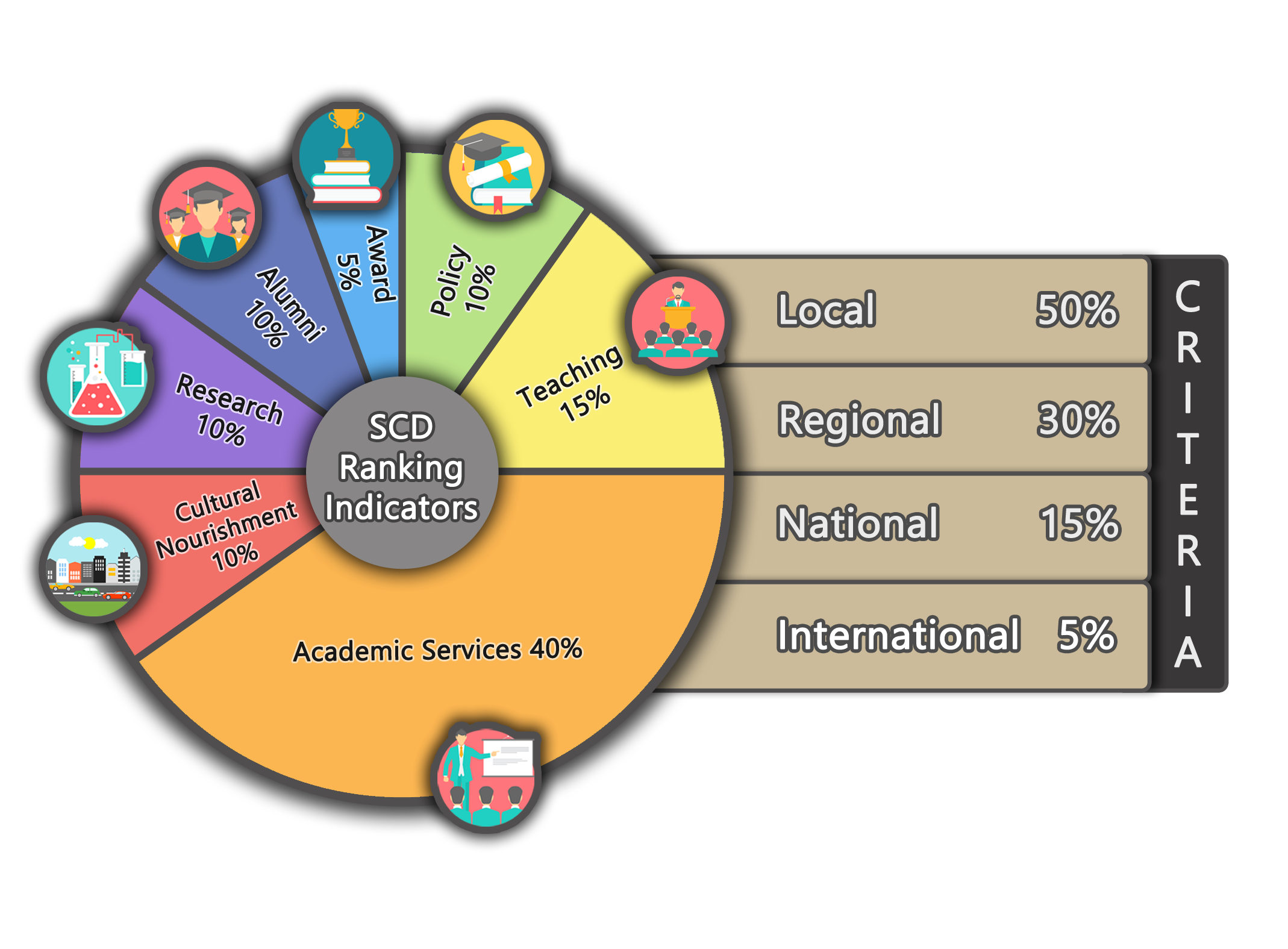
SCD Ranking Indicators:
SCD Ranking aims to measure the degree of sustainable development among universities and their communities. Community can be described in 4 different levels: local; regional; national and international.
Criteria:
Area-Based Impact level (weighted percentage for each particular indicator):• Local 50%
• Regional 30%
• National 15%
• International 5%
Indicators:
I Policy 10%
a. Measure how serious the university emphasizes on community development, reflected by the core policy of the university. 10%
Data Required:
(1) list of all the university’s policies OR The university’s policy quote OR other kind of information that represents the university’s policy (Vision, Missions, etc.) (2) URL that shows the information. Evaluation method: specialists and board committees of the SCDURII Teaching 15%
a. Number of curriculum in community development (8%)
Data Required:
(1) list of all the subjects based general education (eligible for all students to attend) for the year of evaluation: (All subjects) (2) URL that show the above information (1) (3) list of the subjects teaching related to sustainable community Development for the year of evaluation: (SCD subjects) (4) URL that show the above information (3) Evaluation method: (1) fact: ratio of (SCD subjects) over (All subjects)b. Number of students taking community development courses (7%)
Data Required:
(1) total number of existing students for the year of evaluation (All students) (2) URL that show the above information (1) (3) total number of students who attending/passed the SCD subjects for the year of evaluation (SCD students) (4) URL that show the above information (3) Evaluation method: (1) fact: ratio of (SCD students) over (All students)III Academic services 40%
a. Proportion of staffs engaged in community development 10%
Data Required:
(1) total number of existing staff (both academic, research and supporting) for the year of evaluation (All staff) (2) URL that show the above information (1) (3) total number of staff (both academic, research and supporting) who attended the SCD projects/activities within the year of evaluation (SCD staff) (4) URL that show the above information (3) Evaluation method: (1) fact: ratio of (SCD staff) over (All staff)b. Proportion of students engaged in community development 10%
Data Required:
(1) total number of existing students for the year of evaluation (All students) (2) URL that show the above information (1) (3) total number of students who attended the SCD projects/activities within the year of evaluation (SCD project students) (4) URL that show the above information (3) Evaluation method:(1) fact: ratio of (SCD project students) over (All students)c. Number of sustainable community development projects within the year of evaluation 8%
Data Required:
(1) total number of existing projects for the year of evaluation (All projects) (2) URL that show the above information (1) (3) total number of projects that directly involves to SCD projects/activities within the year of evaluation (SCD projects) (4) URL that show the above information (3) Evaluation method: (1) fact: ratio of (SCD projects) over (All projects)d. Number of sustainable community development projects within the three years previously of evaluation 12%
Data Required:
(1) total number of projects that directly involves to SCD projects/activities within the three years previously of evaluation (SCD projects) (2) URL that show the above information (1) Evaluation method: (1) fact: ranking SCD projects among within the three years previously of evaluationIV Cultural Nourishment 10%
a. Number of community cultural nourishment projects within the year of evaluation 3%
Data Required:
(1) total number of existing projects for the year of evaluation (All projects) (2) URL that show the above information (1) (3) total number of projects that directly involves to cultural nourishment projects/activities within the year of evaluation (Cultural projects) (4) URL that show the above information (3) Evaluation method: (1) fact: ratio of (Cultural projects) over (All projects)b. Number of community cultural nourishment projects within the three years previously of evaluation 7%
Data Required:
(1) total number of projects that directly involves to cultural nourishment projects/activities within the three years previously of evaluation (Cultural projects) (2) URL that show the above information (1) Evaluation method: (1) fact: ratio of Cultural projects among within the three years previously of evaluationV Research 10%
a. Number of research publications on community development 10%
Data Required:
(1) list of all the publications that directly related to sustainable community development (SCD papers) (2) URL that show the above information (1) Evaluation method: (1) fact: ranking of SCD papers among the ranking candidatesVI Alumni 10%
a. Number of alumni working in the community within the three years previously of evaluation 5%
Data Required:
(1) total number of alumni that working in the sustainable community development organization within the three years previously of evaluation (SCD Alumni) (2) URL that show the above information (1) Evaluation method: (1) fact: ranking of SCD alumni among within the three years previously of evaluationb. University of alumni within the three years previously of evaluation 5%
Data Required:
(1) total number of alumni that cooperated activities/projects with his/her graduated university within the three years previously of evaluation (Engaged Alumni) (2) URL that show the above information (1) Evaluation method:(1) fact: ranking of engaged alumni among within the three years previously of evaluationVII Award 5%
a. Number of awards in sustainable community development 5%
Data Required:
(1) list of all awards related to sustainable community development that the university itself/staff/alumni/ received for the year of evaluation (SCD Awards) (2) URL that show the above information (1) Evaluation method: (1) fact: ranking of SCD Awards among the ranking candidatesAnalytics data:
For example: Impact level multiplying percentage of indicator and divide by 100%

